
Richard Bell's Wild West Yorkshire Nature Diary, Saturday, 3rd April 2010

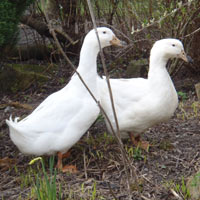
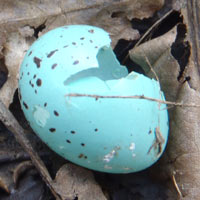 ONE
BROKEN EGG, two white ducks and a patch of daffodils (rather late this year
because of the weather) seem appropriate for an Easter weekend walk. Shown here
larger than life-size, my guess is that this is the egg of a song thrush.
Was it dropped by a magpie or crow? Or did the parent bird dispose of the empty
shell away from the nest after the chick had hatched? I must say that the egg
looks as if it's been smashed open with one swift stab of a beak.
ONE
BROKEN EGG, two white ducks and a patch of daffodils (rather late this year
because of the weather) seem appropriate for an Easter weekend walk. Shown here
larger than life-size, my guess is that this is the egg of a song thrush.
Was it dropped by a magpie or crow? Or did the parent bird dispose of the empty
shell away from the nest after the chick had hatched? I must say that the egg
looks as if it's been smashed open with one swift stab of a beak.
We're so lucky to have a classic patch of English parkland just forty minutes walk away from us at Thornhill Park. Sadly they've recently felled some of the magnificent old trees. Parkland needs management and these days that doesn't mean waiting for a great storm to sweep through to take out any ailing trees. The carunculated old horse chestnut near the old rectory had seen out many a storm but that doesn't mean that it's going to pass a 21st century health and safety assessment.
The Reverend Mulso, a rector of Thornhill in the 18th century, complained that his predecessor had removed an ancient row of trees to the west of the house which had served as a shelter-belt. Mulso complained that in one mighty storm he could feel the rectory shaking, even though the walls were several feet thick.
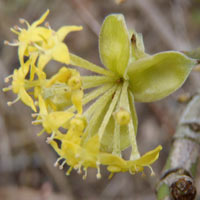
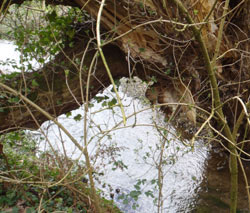 Crack
Willow and Cornelian Cherry
Crack
Willow and Cornelian CherryIt's probably a year since we walked this route (I last drew here on the 2nd April 2009). We like the contrast between the woodland of Coxley Valley, with its tumbling crack willows overhanging the stream (right), and the open arable land on Smithy Brook Lane with views up the Calder valley towards Dewsbury to the right and Thornhill Edge and the tributary Smithy Brook valley to the left.
I first made a note of Cornelian Cherry, Cornus mas (left), in this nature diary nearly ten years years ago (14th October 2000). I'd puzzled over it for a year or so until a friend was able to identify it for me.
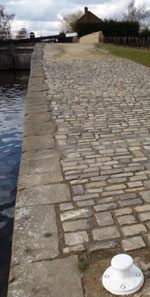 Cobbles
by the Canal
Cobbles
by the CanalFlooding caused by the River Calder overflowing across a narrow strip of land into the canal cut a gulley through the towpath by the Figure of Three locks. This is the first time that I've seen it restored; the cobbles and the drystone wall look superb. There seem to be a lot of skillful stone-wallers around; the work is as good as anything you'll see in the centuries-old drystone walls of the county.
This might be the first time that particular stretch of wall has
been rebuilt since the time of the Reverend Mulso. When the canal was constructed
during his time at Thornhill he wrote to his old friend the Reverend Gilbert
White 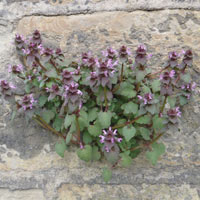 of
Selborne complaining that the work would spoil the view! The mile-long straight
route of the new canal, the Calder and Hebble Navigation, was
made possible by cutting off a graceful meander of the Calder which Mulso considered
a picturesque backdrop to his garden.
of
Selborne complaining that the work would spoil the view! The mile-long straight
route of the new canal, the Calder and Hebble Navigation, was
made possible by cutting off a graceful meander of the Calder which Mulso considered
a picturesque backdrop to his garden.
I have to agree with him; it's a real slog on the last dead-straight mile of towpath on the return leg of our walk. Watching Horbury Bridge get nearer is like watching the light at the end of a long, long tunnel get nearer and nearer by barely perceptable increments.
Red deadnettle (right) is now in flower on the stone embankment alongside the canal at Horbury Bridge.